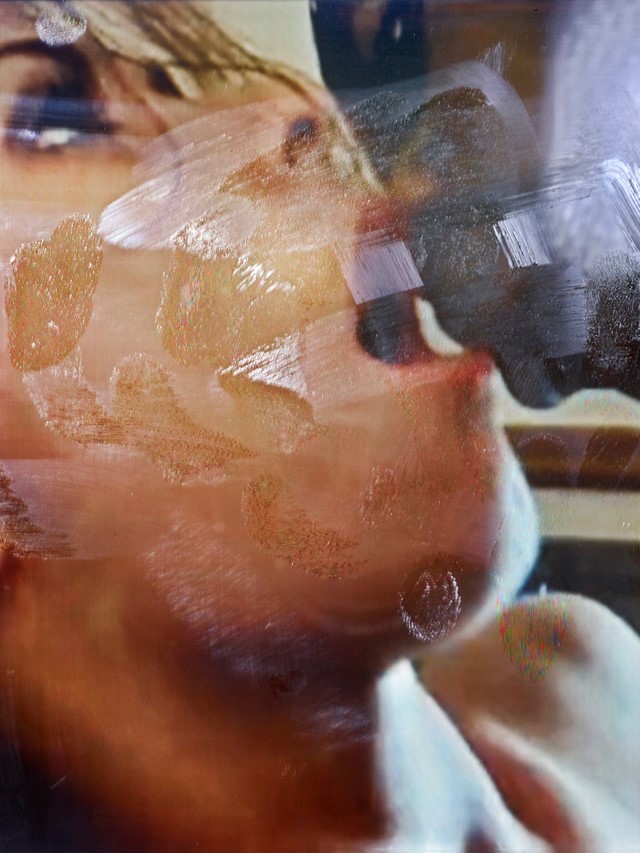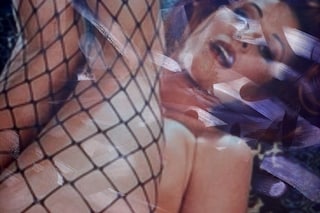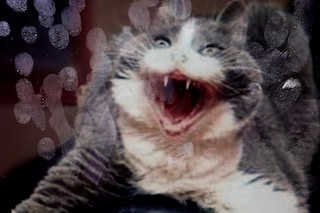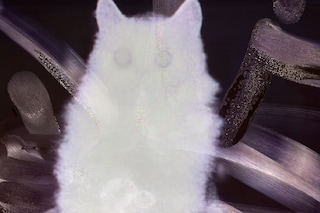Tabitha Soren delves into our digital consumption and the human traces we leave behind by zeroing in on two activities that Americans engage with online more than anything else
Though we may have the world at our fingertips, often the only thing we have to show for the minutes, hours, days gone by are a trail of greasy swipemarks left behind. Mindlessly, we wipe the evidence away and delve back in, sending and receiving photos, videos, and messages in a never-ending stream of digital consciousness.
We rarely consider, let alone see, how these actions change the way we perceive reality. Former television journalist Tabitha Soren took notice of this phenomenon one day while on a plane, reading the manuscript for her husband’s latest book on her iPad. When she turned off the machine, she noticed these grimy finger trails all across the surface. She instinctively whipped out her phone to snap a quick photograph, entranced by the marks of where she had “been”.
This single image became the catalyst for Surface Tension, a series of large-scale photographs that look at how we look, asking us to see beyond the appearance of things. Here, Soren saw an opportunity to reflect on the media we consume, transforming digital detritus into poetic, painterly images of images we might not otherwise see as art, such as America’s two greatest loves: cat videos and porn.
Soren, who got her start appearing in the Beastie Boys’ landmark 1987 music video, “(You Gotta) Fight for Your Right (to Party),” rose to fame as an anchor for MTV News, following Bill Clinton on the 1992 Presidential campaign trail, and interviewing controversial figures from Yasser Arafat to Anita Hill. After reaching the pinnacle of success, she decided to go behind the lens. Below, she speaks with us about the life on the other side of the camera.
“Surface Tension, with all of the residue of sweat and oil from the hands is a map of what we’ve been doing, where we’ve been, and how often we use the machines – but I am also pushing together the technology and the messiness of life to remind people that our humanity is beautiful” – Tabitha Soren
I’ve been watching your work since you were on MTV back in the 90s, interviewing everyone from Bill Clinton to Mariah Carey. What inspired you to move from journalist to artist?
Tabitha Soren: The more successful I got, the more mainstream the venues became for my work and I felt like trying to appeal to all different audiences made the work generic. I went to Stanford to figure out what to do next and while I was there, I fell in love with art photography and art history. It was really exciting to feel passionate about something else.
I am still interested in presenting truth – just a more nuanced version of it. Instead of ‘Who, What, Where, When, and Why,’ it is more about a psychological truth of human nature: why we behave the way we do. My work presents facets of psychology that are not all that mainstream. My world as a journalist didn’t really encompass that.
I’ve been working as an artist longer than I was as a journalist, but more people associate me with an interview with Tupac and I don’t mind that. I don’t want to work in total anonymity but going from 80 million viewers to how many people go to see an exhibit of mine is not a problem. I feel very comfortable in the art world. Even though I was on TV, it was an effort. I’m naturally an introvert. No one in the art world has ever asked me to smile.
As an artist, you have the freedom to create the narrative, to interpret, to translate. You don’t have to follow the supposed “objectivity” of journalism. Do you think art complements or transcends that objectivity that journalism strives to achieve?
Tabitha Soren: I think that they’re complementary. After working in news for 12 years, I think that the shades of grey about truth, about emotions, and about psychology were more compelling to me. There were so many things that were left on the cutting room floor because they were tangents or they were off topic, but sometimes I felt like they were the best parts of the story. Those are the parts I try to pick up and put together in a project now.
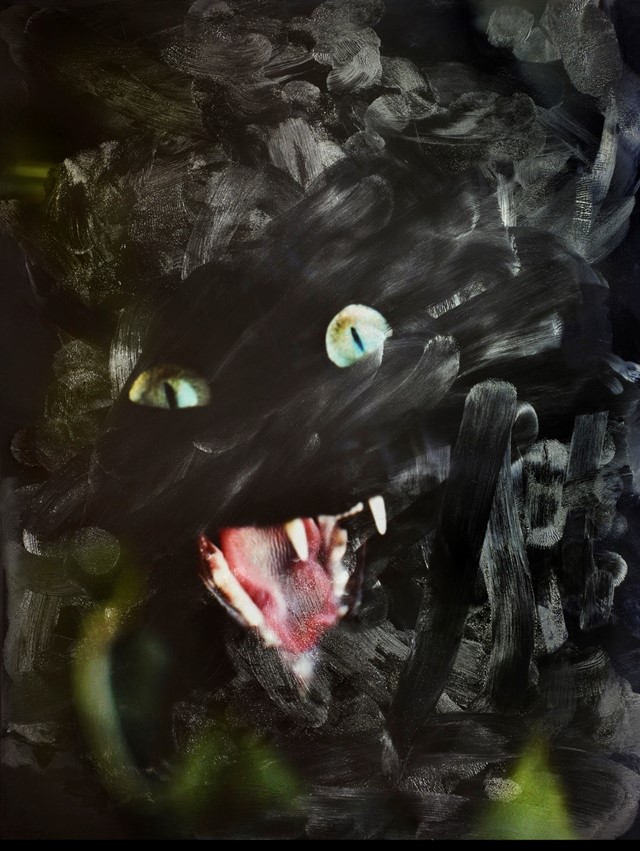
I love how your work reflects the rise of visual culture and the way in which images are supplanting verbal language, which parallels your transformation from journalist to artist. How does Surface Tension embody this?
Tabitha Soren: There’s a picture in Surface Tension of my daughter blowing a kiss. She sent me that picture as a way to kiss me goodnight when I was out of town and thought nothing of calling me. Yes, it’s very sweet, but it’s also indicative of where we are in the culture.
An air kiss, which is a weird form of a kiss, refers to a ‘LOL’ being a weird form of a laugh, and sending around manipulated photographs on digital screens, I think that’s a weird way to transact relationships. My age probably has something to do with it, because my teenage daughters are very comfortable with it.
I wonder if it’s a function of the age we’re in, or the age itself, of being a teenager?
Tabitha Soren: I think it’s very easy for kids, or adults to, for that matter, to mistake the perfection of those devices for the perfection of themselves and that kind of relieves us of the responsibility of what happens in the world.
I’m not trying to say technology’s impact on us is all bad; certainly, there are aspects that are great but I do think that the contrast with the messiness of being a human being is pretty stark. Our hairiness, our oiliness, our saliva, our tears, all of those human responses to life are very messy and they contrast greatly with the minimalist, oleophobic machines that we are carrying around.
Surface Tension, with all of the residue of sweat and oil from the hands is a map of what we’ve been doing, where we’ve been, and how often we use the machines – but I am also pushing together the technology and the messiness of life to remind people that our humanity is beautiful.
Your photos show the physical elements of consumption that most people don’t think about. They also reveal the auto-pilot that happens when we go digital: we become mechanised. I like that you use technology to explore technology and by focusing on the physical elements, you are pausing the autopilot. Was there something you discovered through the process that you didn’t see or intend?
Tabitha Soren: I’m shooting it on film so I can’t see the way it’s going to look until after I get the contact sheets back. I love that surprise of doing your best but not knowing how it’s going to turn out because it’s such a metaphor for the difficult turns and twists of everyday living.
I can’t really see the patterns but when it’s emphasised with the technology that I’m bringing to it on the 8x10 negative, it is showing things that are beyond the capability of my eye. Photography is not so much about the seen but about the unseen: what can be seen with the eye in a photograph is not all there is. All of the pictures are a fundamental battle to transcend the physical. They have the mark of human beings on top of them but it’s so ghostly, it acts almost like an apparition. The best pictures have the power to unlock the realm beyond appearances.
“Who would have ever thought that these are the two activities that Americans engage with online more than anything else?” – Tabitha Soren
And yet, what people immediately connect to is: ooh cat videos – and porn! Surface Tension is reclaiming the value of the forms of media that are consumed thoughtlessly and asking people to look more deeply at their habits. Why do you think cat videos and porn are so popular?
Tabitha Soren: Who would have ever thought that these are the two activities that Americans engage with online more than anything else? I’m certainly not judging it. I came into contact with two university studies that said that after time spent looking at cat videos, your serotonin levels go up. They’re a pleasure and, probably, they make people feel like they’re less alone in the world.
In the case of the porn grid and the cat video grid, they are intended to simulate the idea of the rabbit hole that we all go down when we’re on the Internet. You know: you’re going to go to send an email to someone and you go into your email box and other emails pop up and that sends you to answer them quickly and you think you’re just going to get them out of the way and you’re reminded that you need to buy this thing on Amazon and then you go and you add that to your cart. But then you notice there’s this book and so you look up the author on Wikipedia and all of a sudden you’ve got seven windows open and you still haven’t sent that initial email.
But sometimes you land on something really good and it’s like, ‘Oh my God! Look at this! I had no idea!’ and it’s so exciting – and other times, you’re just burning time and it’s like, “Hmm, do I really need this face cream?” There’s this push and pull between wandering about and zeroing in.
What I was also trying to get at was this mediated life experience that we all have because of our devices. Instead of calling somebody, you text them so you don’t hear their voice, you don’t hear them try to think of the right words, you don’t hear the sounds that they make as a human being, you just text back and forth and it’s wildly efficient – but I think there’s an intimacy that’s lost there. The videos are a substitute for a real cat and a real sexual partner.
I was shocked the way people look at porn, like, ‘Wow, someone’s into that? That’s strange.’ Of course, there’s no normal sexuality anymore. We’re all sophisticated enough to know that everybody likes different things but sometimes it’s still sort of breathtaking, like, ‘Oh, somebody likes to run around in a bunny costume!’
What I found is that the cat videos exhibit the same sort of quirks or passions. One of the cat videos has the cat sitting next to this automatic gun and I just thought, ‘Wow, taking a picture of your white cat with your black gun. What is that saying? Who is this person?’ It makes you very curious not only about the person who watches it but the video but the person who is making the video. It would be easy to see it as funny but they’re much more meaningful after awhile.
See more of Tabitha Soren at tabithasoren.com
